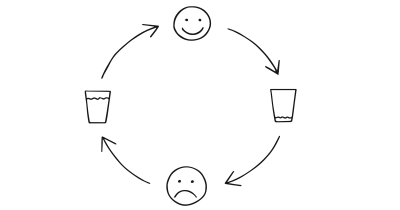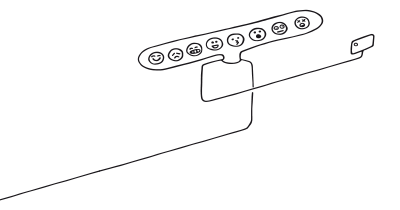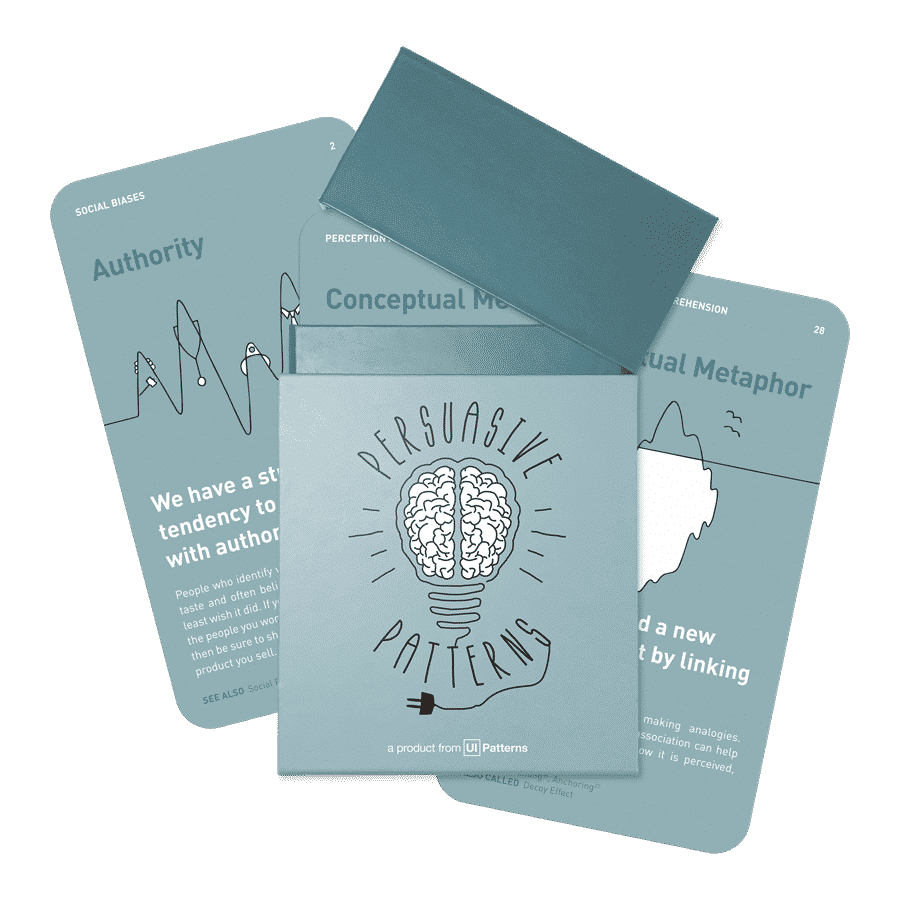Cognitive Bias
This persuasive pattern is part of the Persuasive Patterns printed card deck.
The Persuasive Patterns Card Deck is a collection of 60 design patterns driven by psychology, presented in a manner easily referenced and used as a brainstorming tool.
Get your deck!The IKEA Effect highlights a cognitive bias where people place a higher value on products they’ve partially assembled, customized, or even simply invested effort in creating. This effect can be harnessed in design to foster a sense of ownership, satisfaction, and brand loyalty.
You’re spending an afternoon assembling a bookshelf with your partner. Despite the occasional frustration with cryptic instructions and misplaced screws, a sense of accomplishment washes over you as the final piece clicks into place. This bookshelf, initially just a pile of flat boards, now holds a special significance. You appreciate its sturdiness more because you invested your effort in its creation. This phenomenon is the IKEA Effect in action. Research by Norton, Mochon, and Ariely (2011) supports this concept, demonstrating that people value self-assembled furniture more than pre-assembled options, even if the quality is identical.
The IKEA Effect translates seamlessly into the digital world. Consider a music streaming service that allows users to curate personalized playlists. The platform offers a vast library of songs, but users can also upload their own audio files. These uploaded songs, even if they are obscure or low-quality recordings, might hold a greater value to the user simply because they contributed to the playlist’s creation. This is because the act of uploading personal audio files personalizes the experience and strengthens the user’s connection to the playlist. This aligns with research by Lee, Yeonhee, and Sungho (2014) who found that users who invested effort in creating digital content valued it more than pre-made content.
The study
The term “IKEA Effect” was coined from a seminal study conducted by Michael I. Norton, Daniel Mochon, and Dan Ariely, which investigated the impact of self-assembly on the valuation of objects. The researchers conducted several experiments where participants either assembled IKEA boxes, folded origami, or built sets of LEGO. The study revealed that participants were willing to pay significantly more for items they had assembled themselves, compared to identical pre-assembled items. This demonstrated a clear cognitive bias where labor leads to love, suggesting that the effort invested in creating something enhances its value in the eyes of the creator.
M. I., Mochon, D., & Ariely, D. (2012). The IKEA effect: When labor leads to love. Journal of Consumer Psychology, 22(3), 453-460.
The term itself is a nod to the Swedish furniture company IKEA, which sells many products requiring customer assembly. The researchers chose the name based on the observation that consumers place a higher value on furniture they assemble themselves, regardless of the quality of the end result.
The idea resonates with older psychological theories related to labor and value, dating back to Karl Marx’s concept of “labor theory of value,” where the value of a good is directly related to the labor spent to produce it. In psychology, similar ideas have been explored in relation to effort justification and intrinsic motivation, suggesting that the effort a person invests into an activity enhances their subjective valuation of the outcome.
The IKEA Effect is fundamentally grounded in the psychological principle of effort justification, part of cognitive dissonance theory. This principle suggests that when individuals invest effort into a task, they rationalize the investment by elevating their appreciation or value of the outcome, regardless of the true quality or outcome. This self-inflicted bias ensures that the effort and end result align psychologically, maintaining cognitive consistency.
- Effort justification
This is a specific manifestation of cognitive dissonance where individuals justify the effort they put into an activity by increasing their valuation of the investment’s result. When people spend time and effort on something, they need to feel that those efforts have been worthwhile. This need drives them to value the fruits of their labor more highly than if the same results had been achieved with less or no effort. - Endowment Effect
Closely related to the IKEA Effect, the endowment effect states that people ascribe more value to things merely because they own them. When combined with the IKEA Effect, ownership and effort together significantly boost the perceived value of an item. - Self-efficacy and autonomy
Psychological theories suggest that tasks that enhance an individual’s feelings of self-efficacy and autonomy are particularly satisfying. Building or creating something can fulfill these needs, thereby increasing personal connection and perceived value of the creation. This aligns well with the IKEA Effect, as the act of self-assembly or creation enhances the creator’s sense of competence and independence. - Intrinsic motivation
According to self-determination theory, activities that satisfy intrinsic motivations—those done for their own sake—are more engaging and fulfilling. The IKEA Effect leverages this by tying the intrinsic joy of building or creating directly to the value of the object created.
As the personal effort increases so does the subjective value of an outcome – reinforcing an individual’s motivation, satisfaction, and engagement with the task or product. This in turn helps enhance user engagement and satisfaction by incorporating elements of personal effort and creation into the user experience.
Designing products through the IKEA Effect
By encouraging users to invest personal effort into the customization or creation of products, customer engagement and loyalty can be enhanced significantly. Let’s examine how the IKEA Effect can be applied while ensuring a balance between user involvement and ease of use to maximize customer satisfaction and value perception.
Provide opportunities for users to personalize or co-create products. This could range from simple customization options to more involved activities like user-generated content platforms. For instance, allowing users to design their own software dashboards or customize sneakers not only enhances user engagement but also increases their emotional attachment and perceived value of the product.
Break down the creation process into smaller, achievable steps to prevent users from feeling overwhelmed. This is similar to building a fitness app where users add exercises one at a time to create a personalized routine, allowing users to experience a sense of accomplishment at each step. Celebrate these micro-achievements to reinforce the IKEA Effect and encourage continued engagement.
Recognizing user contributions can further help. Whether through profiles that display user designs, leaderboards for contributions, or personalized feedback mechanisms, acknowledging user efforts strengthens their connection to the product. Public recognition not only boosts the individual’s sense of achievement but also demonstrates the value of their contribution to the community, increasing product loyalty.
The process of creation should be as engaging as the end product. Designing the creation journey to be enjoyable and interactive can significantly enhance user satisfaction. This could involve integrating gamification elements, providing clear instructions, progress tracking, or enabling social interactions. Ensuring that the process is accessible and inclusive allows a broader range of users to participate and enjoy the experience.
Consider offering periodic upgrades or new customization options to maintain interest over time and prevent disengagement – keeping the product relevant and allowing users to revisit the satisfaction of personal involvement.
Best practices for implementing the IKEA Effect are:
- Keep tasks simple and manageable. Ensure that tasks are not overly complex to avoid user frustration.
- Provide clear instructions. Help users succeed with concise and helpful guidance.
- Balance effort and reward. Align the level of user effort with appropriate rewards to maintain motivation.
- Identify opportunities for user-created elements. Look for ways to incorporate user customization into existing products or services.
- Market the value proposition. Frame these changes as value-added experiences, not labor-saving exercises. Highlight how user participation benefits them.
- Early personalization. Provide personalization options early in the user flow. This fosters a sense of ownership and reduces drop-off rates later in the process.
- Conduct user testing. Gather feedback to understand user interactions and refine product designs accordingly.
Collecting and analyzing user feedback is crucial for refining product designs and enhancing user satisfaction. Understanding how users perceive their efforts and the value they derive can provide invaluable insights for future product enhancements.
Ethical recommendations
The IKEA Effect, which enhances the value users place on products they have helped to create, holds significant influence in product design and user experience. However, this effect can be misused if not managed responsibly.
One potential misuse is overburdening users with tasks that are too complex or require too much time, under the guise of enhancing their attachment to the product. This can lead to user frustration and fatigue, ultimately causing a negative association with the product.
Furthermore, companies might exploit this effect by intentionally designing products that require frequent, unnecessary adjustments or customizations that do not genuinely enhance the user experience but rather serve to increase perceived value artificially.
- Deceptive effort
A company might create a false sense of personalization through superficial customization options. This inauthentic experience undermines the core principle of user investment and can damage trust. - Exploiting time
Overly complex or time-consuming personalization processes can exploit user time and effort without delivering a truly valuable outcome. This can lead to frustration and negatively impact the user experience. - Hidden costs
Companies might leverage the IKEA Effect to justify charging a premium for products with minimal user customization options. Transparency is crucial to ensure users understand the true value proposition.
To ensure that the application of the IKEA Effect remains ethical and user-centric, consider the following best practices:
- Focus on meaningful participation
Personalization options should offer genuine user control and impact the final product or service in a substantial way. - Respect user time
Keep customization processes concise and user-friendly. Don’t waste user time with tedious or unnecessary steps. - User control and consent
Always give users control over how much they want to engage in the customization process. Provide options to opt-out or limit their involvement without penalizing their product experience. - Balance effort and reward
Ensure that the effort required from users is proportional to the benefits they receive. Avoid setting unrealistic expectations about the outcomes of their involvement to prevent disappointment and distrust. - Support and guidance
Offer adequate support and guidance throughout the customization process. Ensure that help resources are readily available so that users feel supported rather than overwhelmed by the tasks required. - Transparency in value
Clearly communicate the value proposition associated with user customization. Don’t mislead users about the level of control or the benefits they receive. - Prioritize user satisfaction
The ultimate goal should be user satisfaction. Don’t prioritize business objectives like increased effort or time spent on customization at the expense of user experience.
Examples
IKEA
IKEA puts a small cafe selling cinnamon buns, ice cream and other treats near the registers in each store to create a great end-experience.
Trello
Trello allows users to customize boards for project management. This customization process ensures that users are deeply engaged with the interface and its content, as they build it to suit their specific workflow needs. The more effort users put into setting up their boards, the more valuable the boards become to them, thus increasing retention and the likelihood of upgrading to premium features.
Canva
Allows users to design graphics from templates they can customize. The process of creating a design from scratch or modifying an existing template makes users feel more connected to their creations, enhancing the perceived value of their work. Users are more likely to share their designs on social media or upgrade to premium features to unlock more design options, thereby increasing user engagement and revenue for Canva.
Lego
Lego kits require assembly from simple blocks to create intricate models. This process increases the value placed on the final product by the builder, leveraging the IKEA Effect to enhance customer satisfaction and perceived value.
Trigger Questions
- Can users customize core aspects of our product or service?
- How do we ensure the customization process enhances the product's value to the user?
- Are the tasks we're asking users to perform suitably challenging yet achievable?
- What kind of support and resources can we provide to facilitate a smooth creation process?
- In what ways can we acknowledge and celebrate the user's contributions to the product?
Pairings
IKEA Effect + Endowment Effect
This pattern involves a heightened valuation of possessions simply because they are owned. When combined with the IKEA Effect, users not only value items they create more but also those they own, intensifying their attachment and reducing the likelihood of switching to competing products. Allow users not just to create but also to modify existing elements, which can make them feel more in control and attached to the outcome.

We place a disproportionately high value on products we helped create

We value objects more once we feel we own them
IKEA Effect + Feedback Loops
Incorporating feedback loops that acknowledge and reward users for their participation can enhance the IKEA Effect. As users see real-time responses to their customization efforts, their engagement and satisfaction with the product increase. Ensure that the feedback provided during the customization process is meaningful and constructive. This can involve positive reinforcement when users make choices or progress, enhancing the value of their efforts.

We place a disproportionately high value on products we helped create

We are influenced by information that provides clarity on our actions
IKEA Effect + Goal-Gradient Effect
These tools visually track progress, which can motivate users to continue their efforts in customization or creation. The closer users get to completing their creation, the more they value the end product, leveraging both the IKEA Effect and Goal-Gradient effects. Specifically, define clear milestones within the product interaction to encourage continual engagement. This can help maintain momentum in long-term projects or complex customizations.

We place a disproportionately high value on products we helped create

Our motivation increases as we move closer to a goal
IKEA Effect + Tailoring + Self-Expression
Allowing users to express themselves through product customization not only utilizes the IKEA Effect but also taps into users’ desires for self-expression. This makes the product more personally significant and valued.

We place a disproportionately high value on products we helped create

Adapt the offerings of a system to match individual users- needs and abilities

We seek opportunities to express our personality, feelings, or ideas
IKEA Effect + Achievements + Rewards
Applying gamification elements like achievements or rewards for certain stages of product creation or customization can make the process more enjoyable and engaging, further enhancing the value placed on the final product due to the IKEA Effect.

We place a disproportionately high value on products we helped create

We are engaged by activities in which meaningful achievements are recognized

Use rewards to encourage continuation of wanted behavior
IKEA Effect + Social Proof
Showcasing how other users have successfully customized or created products can motivate new users to engage deeply. Seeing others’ satisfaction can reinforce the perceived value of the effort involved. Imagine a fitness app that allows users to personalize workout routines and share them with friends. The IKEA Effect increases the perceived value of the personalized plan, while social proof from friends using the same plan strengthens motivation and engagement. (Example: Peloton utilizes both effects by allowing users to create custom playlists and follow friends’ rides)

We place a disproportionately high value on products we helped create

We assume the actions of others in new or unfamiliar situations
This persuasive pattern is part of the Persuasive Patterns printed card deck.
The Persuasive Patterns Card Deck is a collection of 60 design patterns driven by psychology, presented in a manner easily referenced and used as a brainstorming tool.
Get your deck!- The IKEA effect: When labor leads to love by Norton, Mochon & Ariely
- The ontogeny and mechanisms of the IKEA effect by Marsh, Kanngiesser & Hood
- IKEA Effect
- IKEA effect at Wikipedia (en)
- Norton, M. I., Mochon, D., & Ariely, D. (2012). The IKEA effect: When labor leads to love. Journal of Consumer Psychology, 22(3), 453-460.
- Ariely, D., & Norton, M. I. (2009). Conceptual consumption. Annual Review of Psychology, 60, 475-499.
- Mochon, D., Norton, M. I., & Ariely, D. (2012). Bolstering and restoring feelings of competence via the IKEA effect. International Journal of Research in Marketing, 29(4), 363-369.
- Schreier, M., Fuchs, C., & Dahl, D. W. (2012). The innovation effect of user design: Exploring consumers' innovation perceptions of firms selling products designed by users. Journal of Marketing, 76(5), 18-32.
- Lee, J. Y., Yeonhee, K., & Sungho, L. (2014). The IKEA effect in online travel planning: When effort invested in trip planning enhances travel satisfaction. International Journal of Hospitality Management, 36, 272-282.
- Kruger, J., Wirtz, D., Van Boven, L., & Altermatt, T. W. (2004). The effort heuristic. Journal of Experimental Social Psychology, 40(1), 91-98.
- Marsh, L. E., Kanngiesser, P., & Hood, B. (2018). When and how does labour lead to love? The ontogeny and mechanisms of the IKEA effect. Cognition, 170, 245-253.
- Sarstedt, M., Neubert, D., & Barth, K. (2017). The IKEA Effect. A conceptual replication. Journal of Marketing Behavior, 2(4), 307-312.
- Ariely, D. (2010). Predictably Irrational: The Hidden Forces That Shape Our Decisions. Harper Perennial.
- Csikszentmihalyi, M. (1990). Flow: The Psychology of Optimal Experience. Harper & Row.
- Festinger, L. (1957). A Theory of Cognitive Dissonance. Stanford University Press.
- Aronson, E. (1968). Dissonance theory: Progress and problems. Advances in experimental social psychology, 4, 1-28.
- Kahneman, D., Knetsch, J. L., & Thaler, R. H. (1991). Anomalies: The endowment effect, loss aversion, and certainty equivalent. Journal of economic perspectives, 5(1), 141-155.
- Markus, H., & Wurf, E. (1987). The self as a source of continuity in life history narrative. Journal of personality and social psychology, 53(2), 1062-1072.
